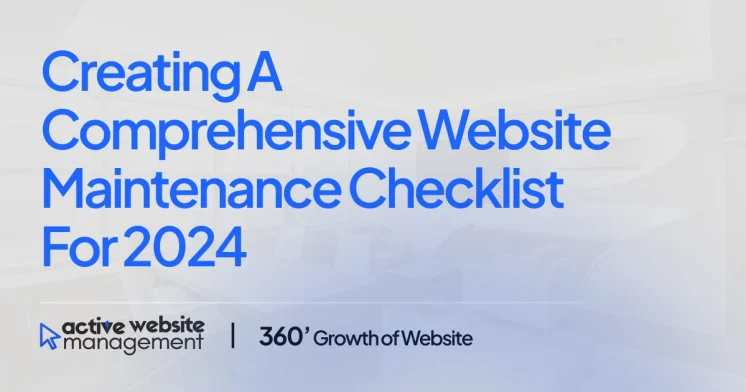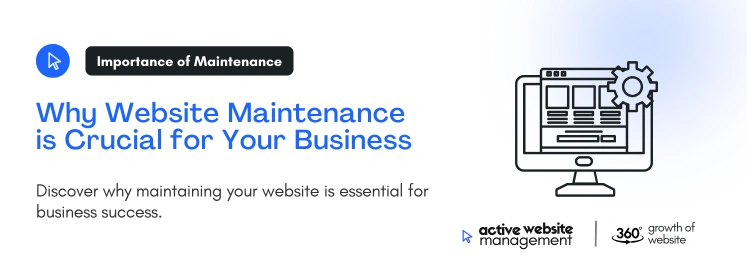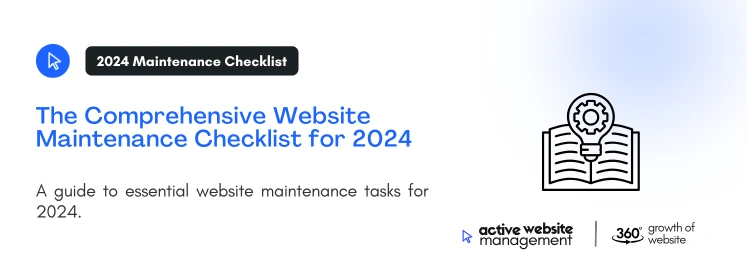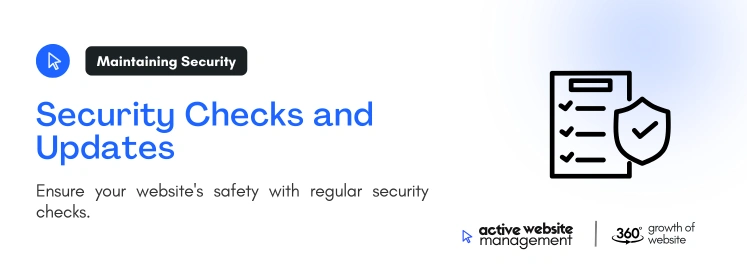
Managing a website isn’t a “set it and forget it” task. For businesses looking to maintain a competitive edge online, regular maintenance is essential to ensure security, functionality, and optimal performance. In fact, websites that undergo routine maintenance see better search engine rankings, faster load times, and stronger user engagement.
This article presents a comprehensive website maintenance checklist designed to keep your website in top shape for 2024 and beyond. From security to content updates, performance monitoring, and SEO optimization, we will cover the essential practices to ensure your site stays up-to-date and effective.

Before diving into the checklist, it’s crucial to understand the importance of maintaining your website. Whether you’re a small business owner or managing a large corporate site, regular website maintenance offers several key benefits:
In 2024, with more businesses relying on their online presence than ever before, staying on top of website maintenance is crucial for growth and success.


Website security is arguably the most critical aspect of website maintenance. With the constant evolution of cyber threats, regular security checks help prevent malicious attacks and data breaches.
Don't Wait for Growth—Accelerate It with Active Website Management
Ensure that your content management system (CMS), plugins, and themes are up-to-date. Many security vulnerabilities occur when outdated software is exploited. Regular updates often include important security patches.
Ensure that your website has an active SSL certificate (HTTPS). Not only does this secure the connection between your site and its users, but it’s also a Google ranking factor.
Run monthly security scans to check for vulnerabilities, malware, or unauthorized activity. Tools like Wordfence, Sucuri, or your hosting provider’s security features can help you identify potential threats early.
Backups are essential for disaster recovery. If your website crashes or is hacked, having a recent backup ensures you can restore it with minimal downtime.
Use plugins like UpdraftPlus, BackupBuddy, or a hosting service that offers automated backups. Schedule these backups daily or weekly, depending on how frequently you update your site.
Store backups off-site, such as on cloud platforms like Google Drive, Dropbox, or AWS. This ensures that even if your main server is compromised, your backup data remains secure.
Periodically test restoring backups to verify that they work properly. It’s essential to ensure that in case of a website crash, you can quickly recover your site with minimal downtime.
A slow-loading website can deter visitors, negatively impact SEO, and hurt conversion rates. Optimizing speed should be a regular part of your website maintenance routine.
Use tools like Google PageSpeed Insights, GTmetrix, or Pingdom to analyze your site’s loading times. Ideally, your site should load in under 3 seconds.
Don't Wait for Growth—Accelerate It with Active Website Management
Large images can significantly slow down your website. Use compression tools like TinyPNG or an image optimization plugin to reduce file sizes without compromising quality.
Enable browser caching to improve load times for returning visitors. This allows users to store a cached version of your site, resulting in faster subsequent visits.
Ensure that your hosting plan can handle your traffic and website size. Upgrading to a VPS (Virtual Private Server) or dedicated hosting may be necessary as your website grows.
Broken links and 404 errors create a poor user experience and can negatively impact SEO. Regularly checking for and fixing broken links ensures that your site remains functional.
Use tools like Ahrefs or Broken Link Checker to identify and fix broken links on your site. Update or remove any links that lead to 404 pages or outdated content.
If you’ve removed or moved content, set up 301 redirects to guide users and search engines to the new or relevant page. This helps retain SEO value and ensures users land on the correct content.
Keeping your content fresh and relevant not only improves SEO but also engages your audience more effectively. Content updates should be made regularly to ensure your website is current.
Update older blog posts, service pages, and product descriptions to reflect new information or changes in your business. Outdated content can harm user trust and reduce search engine rankings.
Publishing new content keeps your website active and boosts SEO. Schedule blog posts, case studies, or product updates to maintain consistency.
Duplicate content can confuse search engines and negatively impact your rankings. Use tools like Copyscape to ensure your website doesn’t have duplicate pages or posts.
Learn How to Create a Powerful Content Strategy to Drive Search Engine Traffic to Your Website
Technical SEO is the backbone of how well search engines can crawl, index, and rank your website. Regular SEO audits ensure that your site is optimized and free of technical errors.
Google Search Console is an essential tool for identifying crawl errors. Fixing these errors ensures that Google can properly index your website.
Ensure your XML sitemap is updated and submitted to search engines. Review your robots.txt file to ensure it’s not accidentally blocking any important pages.
Review and update your meta titles and descriptions to improve click-through rates from search engines. Each page should have unique and keyword-rich meta tags.
Schema markup helps search engines better understand your content, improving the chances of rich results like featured snippets. Review and implement appropriate schema for your website.
Tracking your website’s performance through analytics provides insights into user behavior, traffic, and conversion rates. Monitoring these metrics allows you to make data-driven decisions.
Ensure that Google Analytics is properly set up to track key metrics such as traffic, bounce rates, and conversions. Regularly review these metrics to understand user behavior.
Use Google Tag Manager or built-in analytics features to track important conversions like form submissions, product purchases, or sign-ups. This helps gauge the effectiveness of your calls to action.
Use monitoring tools like UptimeRobot or Pingdom to receive alerts if your website goes down. Regular uptime monitoring ensures that issues are detected and resolved quickly.
With mobile traffic accounting for over half of all web traffic globally, ensuring your website is fully responsive is essential.
Use Google’s Mobile-Friendly Test to ensure that your site works seamlessly on smartphones and tablets. Regularly review your website’s mobile version to ensure proper display and functionality.
Ensure your website functions correctly on all major browsers (Chrome, Firefox, Safari, Edge). Cross-browser testing can catch compatibility issues early, preventing poor user experiences.
Regularly test all forms, such as contact forms and checkout processes, to ensure that they work properly. A broken form can result in lost leads or sales, negatively impacting your business.
Running a website that performs well, remains secure, and drives traffic requires consistent maintenance and expertise across multiple areas. This is where Active Website Management (AWM) comes into play. With AWM, you can offload the burden of website maintenance to a team of experts, ensuring your website is always in top condition.
AWM handles all aspects of your website’s security, including regular updates to your CMS, plugins, and themes. Additionally, AWM ensures that your site’s performance is continuously monitored, implementing speed optimizations as needed.
AWM ensures that your website is backed up regularly and stored in secure locations. In the event of a crash or hack, AWM’s quick restore process minimizes downtime.
Active Website Management ensures your content is consistently updated and optimized for search engines. With regular content reviews and new content creation, AWM helps boost your SEO rankings.
With AWM, your website receives frequent technical SEO audits to ensure optimal crawlability, resolve errors, and implement structured data for better search visibility.
AWM provides regular reports on website performance, traffic, and conversions, helping you make informed decisions about your digital strategy.
By partnering with Active Website Management, you free up time to focus on your core business while professionals take care of every aspect of your website’s health, performance, and growth.
Regular website maintenance is essential for businesses that want to stay competitive in the digital landscape. By following this comprehensive website maintenance checklist for 2024, you can ensure that your website remains secure, performs well, and attracts more visitors. If managing all of this sounds overwhelming, Active Website Management provides a complete solution for businesses looking to keep their website at peak performance, 24/7.
Stay ahead of the competition and ensure your website thrives in 2024 with consistent and professional website maintenance practices.

Be quick! Spots are almost gone for September. - Starts at ₹6666/month
Get started with AWM today and watch your website grow.
Our expert team is ready to help.
We respect your privacy. Unsubscribe anytime.
We respect your privacy. Unsubscribe anytime.









